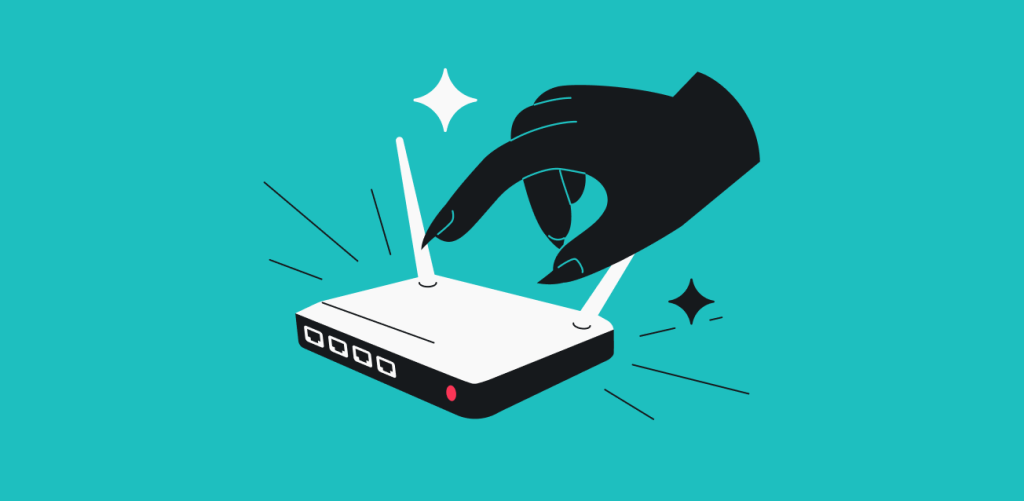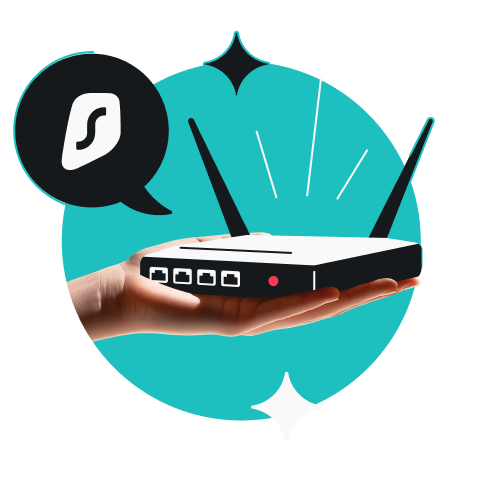
Your router is a gateway between your devices and the internet — it’s crucial to keep it secure in order to protect your personal information. Have you noticed any unusual activity or slower-than-usual internet speeds? These could be signs that your router is compromised.
In this article, we’ll explore how to check if your router is hacked and share practical tips to protect it from future attacks.
Table of contents
How do routers get hacked?
There are various methods for hacking routers used to exploit different vulnerabilities. Here’s an overview of these methods:
Compromised login credentials
The easiest way to compromise someone’s router security is by knowing or guessing their login credentials. Hackers use this method to gain access by targeting people who have never changed their default router username and password set by the manufacturer.
For example, they can use a simple dictionary attack — a type of brute force attack — to try common password combinations like admin/admin or password123 and break into your router’s settings.
Firmware vulnerabilities
Firmware is the software that runs on your router, which is often prone to bugs or vulnerabilities. Hackers may exploit these defects to gain control of your router. Then, they can change your router settings or intercept traffic to gain permanent control.
For example, they could exploit a known flaw in the router’s DNS (Domain Name System) settings to redirect all traffic to malicious websites without your knowledge — opening doors to phishing or malware attacks.
DNS hijacking
DNS hijacking happens when a hacker changes your router’s DNS settings to redirect your internet traffic. In this case, you may be sent to some malicious website that could steal your data or install malware on your device.
For example, suppose you visit your bank’s website, but due to DNS hijacking, you’re taken to a fake site that looks identical but is not your bank’s official site. You don’t notice the difference, so you enter your login credentials there. Then, the hacker gets this data and could use it to hack your financial accounts.
Weak encryption or no encryption
If your router uses weak encryption, such as WEP (Wired Equivalent Privacy), or no encryption, it leaves your network highly vulnerable to hacking. WEP is an older encryption standard that is infamously insecure because it uses a static encryption key. It can be easily cracked using freely available software tools.
This way, hackers can intercept the data transmitted between your router and connected devices and quickly break the WEP encryption. To avoid these consequences, you should use stronger encryptions like Wi-Fi Protected Access 3 (WPA3) to keep your internet traffic more secure.
For example, a hacker near your home could use a tool like Aircrack-ng to break into a poorly encrypted Wi-Fi network and access your router. From there, they could compromise your computer and other devices, steal sensitive files, or monitor your activity.
Vulnerable remote management features
Many routers have remote management features that allow users to access their router settings from anywhere. If this feature is enabled and not properly secured, it provides an easy entry point for hackers.
For example, they can scan the internet for routers with remote management and use default or easily guessable credentials to log in and take control of your router.
Phishing attacks
Hackers can trick you into giving them access to your router through phishing attacks. They may do this by sending you a fake email or message that appears to be from a trusted source.
This email may ask you to log in or change your router settings. If you believe it and enter your details, they will have access to your information and potentially exploit it.
For example, you receive an email claiming to be from your ISP (Internet Service Provider). It asks you to update your router settings by clicking a link. The link then takes you to a fake login page where the hacker can steal your credentials.
Signs that someone hacked your router
In October 2023, a cyberattack in the US compromised over 6,000 routers due to weak login credentials or an exposed administrative interface. This shows that anyone can be a victim of router hacking without even knowing it. Here are some warning signs that will help you understand how to tell if your router has been hacked:
Unfamiliar devices connected to your network
One of the clearest signs that your router has been compromised is the presence of unknown devices connected to your network. Every device that connects to your Wi-Fi has a unique identifier, like a MAC address, that can be seen in your router’s settings.
Hackers who gain access to your router can connect their own devices to your network, using your internet connection to carry out malicious activities or simply to leech bandwidth. So, if you notice an unknown device listed in your router’s admin interface, it could be a hacker’s device piggybacking off your network.
Slower internet speeds
A sudden drop in internet speed can sometimes happen, especially if your neighbors steal your Wi-Fi. But this can also indicate that someone is using your bandwidth without your permission. You may notice this if your internet connection was previously stable and fast.
If usual activities like streaming a movie or web browsing start unexpectedly lagging or buffering, it could be a sign that unauthorized users are consuming your available bandwidth.
Tampered router settings
If you notice changes to your router settings that you did not make, this is a strong indicator that someone has gained unauthorized access. It can be anything like modifications to DNS settings or disabling security features. Even changes to your Wi-Fi network name (SSID) and password strongly indicate router hacking.
You might discover that your router’s firewall is turned off or your network’s SSID has been changed. These changes can be subtle but clear signs of unauthorized access. Hackers do this to redirect your internet traffic and lock you out of your own network.
Increased data usage
A sudden spike in data usage higher than your normal use can also indicate that someone uses your internet connection for data-heavy activities. Hackers may use your network to participate in illegal activities or run data-intensive applications like cryptocurrency mining.
As a result, you could receive a notification from your internet service provider (ISP) about exceeding your data cap, even though your usage is the same as before.
Inaccessible router settings
If you suddenly can’t log in to your router’s admin panel with your usual credentials, it’s a strong sign that your router has been hacked. Hackers often change the victim’s login details to lock the legitimate owner out and control the network without interference.
Unfamiliar downloads
Did you suddenly see an app or software you don’t remember downloading on your device? This can indicate that a hacker could have used your network to install malicious software, such as malware or spyware.
Later, they could use this software to steal your data and spy on your activities. These downloads may also be part of a broader attack to gain further control over your network and use it illegally.
Increased pop-ups on your devices
An increase in intrusive pop-up advertisements, especially ones that appear on multiple devices simultaneously, is a sign of router hacking. Hackers can change your router’s DNS settings to redirect traffic through malicious servers that flood your devices with pop-up ads. Some of these might lead to phishing sites or malware downloads, too — so be cautious.
What to do if your router is hacked
If you suspect your router has been compromised, it’s time to act swiftly and methodically. No need to worry — we’ve got solutions for you. Follow these tactics to regain control and fortify your network against future attacks.
Disconnect the router from the internet
You can disconnect the router from the internet to stop any malicious activity immediately and prevent the hacker from continuing to access or control your network remotely.
To disconnect:
- Wired routers: unplug the Ethernet cable that connects your router to the modem.
- Wireless routers: power off the router by unplugging it from the electrical outlet or using the power button.
Once disconnected, see if all devices connected to the router are also disconnected from the network to prevent ongoing data transmission.
Reset your router
You can also reset your router to factory settings to remove any unauthorized changes a hacker makes, such as altered DNS settings and login credentials.
To reset your router:
- Find the small reset button on the back or bottom of your router.
- Use a pin or paperclip to press and hold the reset button for 10-20 seconds or until the router’s lights start blinking.
- Wait for the router to fully reboot. After that, it will be set to default factory settings.
- Log back into the router using the default credentials (usually printed on the router) and change your name/password.
Update router firmware
Updating your router’s firmware ensures that any known vulnerabilities are patched and your router is safe from future attacks.
To update your router firmware:
- Use your web browser to access the router’s admin panel by typing the router’s IP address in the address bar.
- Look for a section like Firmware, Software Update, or Maintenance in the router’s admin interface.
- Click on the option to download the latest firmware update. Do not disconnect or interrupt the router until the update is installed.
Change all router and Wi-Fi passwords
You can also change your router’s admin credentials and Wi-Fi password to prevent the hacker from regaining access to your network with old credentials.
To change all router and Wi-Fi passwords:
- Go to the router’s admin panel using your IP address.
- Head to the option that allows you to change the router’s admin username and password. Choose a strong, unique password with letters, numbers, and symbols.
- Go to the Wi-Fi settings section and change the Wi-Fi password using a strong password.
Contact your ISP for assistance
Your ISP can offer technical support to help confirm if your router has been compromised and guide you through additional security measures.
To contact your ISP:
- Call your ISP’s support line.
- Explain that you suspect your router has been hacked and describe any unusual activity you’ve noticed.
- Follow their instructions to secure your router.
How to protect your router from getting hacked
To secure your router against potential hacking attempts, it’s better to implement some preventive measures in advance rather than worrying about it later. Here’s a list of the most effective methods to prevent router hijacking:
Change default login credentials
Most routers come with default login credentials, which are widely known and easily guessable. To prevent hackers from guessing your credentials:
- Enter your router’s IP address to access the admin panel and enter your default credentials.
- Go to the admin settings and look for Security or a similar option.
- Create a new, strong username and password that combines uppercase and lowercase letters, numbers, and symbols.
- Now confirm your new credentials to save them.
Update router firmware regularly
Firmware updates include patches for security vulnerabilities that hackers could exploit. To update your router firmware:
- Login to your admin panel and look for an option to install firmware updates.
- Click the option to check for the latest firmware version.
- If an update is available, download and install it.
- If your router supports automatic updates, enable them to always have the latest firmware.
Disable remote management features
Remote management allows you to access your router’s settings from anywhere over the internet. While convenient, it can also open a potential entry point for hackers. To disable remote management features:
- Go to your router’s admin panel using its IP address.
- Look for settings labeled Remote Management, Remote Access, or similar.
- Disable remote management to prevent unauthorized access outside your network.
Use WPA3 encryption for Wi-Fi security
WPA3 is the latest and most secure encryption standard against password guessing and other attacks compared to older standards like WPA2 or WEP. To enable WPA3 encryption on your Wi-Fi:
- Navigate to wireless security settings in your router’s admin panel.
- Select WPA3 from the list of available encryption methods. If WPA3 is not available, use WPA2 as the next best option.
- Set a strong password to secure your network, then save changes.
Enable a guest network for visitors
A guest network allows visitors to connect to your internet without accessing your main network, which keeps your devices and data more secure. To set up a guest network:
- Find the guest network settings in your router’s admin panel and turn on this feature.
- Set up a guest network SSID and a unique password for your guest network.
- Configure the guest network to restrict access to your main network and personal devices, and then Save settings.
Turn off WPS
WPS (Wi-Fi Protected Setup) makes device connection to your Wi-Fi network easier. But, it is often considered insecure because hackers can exploit it to access your network. So, to turn off your WPS:
- Look for settings labeled WPS, Wi-Fi Protected Setup, or similar in your admin panel setup.
- Turn off this feature to prevent it from being used as an attack vector, and then confirm by saving the changes.
Use a VPN
A VPN encrypts your internet traffic and redirects it to a different location through a remote server. This makes it very difficult for hackers to intercept or tamper with your data. To secure your router with a VPN:
- Choose a reputable VPN provider that supports router installation.
- Complete the VPN downloading and setup.
- In your router’s admin page, look for a section labeled VPN, OpenVPN, or a similar option.
- Follow your VPN provider’s instructions to configure the VPN on your router. You might have to upload configuration files or enter specific settings.
- Once configured, turn the VPN on.
- Now, when you visit a site, you will notice that your internet traffic is routed through the VPN. This site will show you the VPN server location instead of your own.
Secure your router with a reliable VPN
Router security is a serious issue, especially with today’s rapidly growing internet traffic. So, always be vigilant and take proactive steps. A VPN like Surfshark can make all the difference — it provides extra protection by masking your IP address to make it nearly impossible for hackers to intercept.
This way, you can easily protect your online activities and work peacefully, knowing your network is well-protected against potential threats.
FAQs
Can someone hack my router remotely?
If remote management is enabled and the router’s security weakens, your router can potentially be hacked remotely.
How do I tell if my router is hacked using an iPhone?
Go to your iPhone’s Wi-Fi settings and look for unknown devices connected to your network. You can also track unusual internet activity using network management apps and confirm if someone has hacked your router.
Does resetting the router stop hackers?
Yes, resetting the router can remove unauthorized changes made by hackers. However, it is better to take additional security steps, like always using a VPN, to secure your IP and prevent future attacks.


